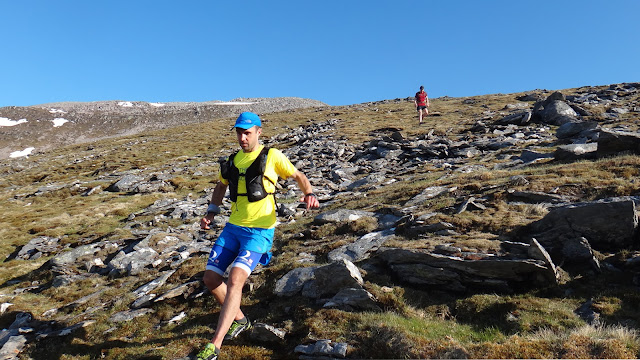Written by Jez Bragg - http://jezbragg.blogspot.fr
 |
||||
 |
Written by Mark Enser - http://herbifit.com
I run through the mud, low branches whipping at my legs and others aimed at my head. I dodge through the trees as my eyes scan ahead hoping to find a break in the vegetation that will let me find a path or at least an opening that will let me get my barings. It wasn’t suppose to to be like this. I had set out for a short run along a track through the forest, somewhere I have run dozens of times before but this time I spotted something new. A small trail leaving the main path and waking off through the forest. How could I resist. Now I am lost. The trail must have stopped being a trail a few meters in and turned into nothing more than deceptively straight gaps between the trees. My legs are starting to tire and I wish I had brought more to drink. So, why do I do these crazy things? Why not stick to the safe and easy roads and parks? A million reasons but here are my top five.
1. Peace. Few places are as peaceful as the top of the South Downs or deep in a wood at dawn or dusk. Few people want to use these magical places and there is enough space to lose yourself. After sitting in a car on a long commute and being surrounded by people all day the last thing I need is to dodge the traffic and crowds on my runs.
2. Fitness. Trails make you strong. Paths are constantly undulating (by which I mean endless hills, and oddly more ups than down) and hill work builds good form and powerful.legs. Hill work gives you speed when, or if, you get back to the roads.
3. Injury. Running on the roads usually means hitting the same part of your foot at the same force time after time. On the trails you are forced to change your gait and cadence with every step and avoid the worst of those repetative injuries.
4. Wildlife. Last time I went trail running I saw.a pair of buzzards circling over a valley sending rabbits in all directions. I saw a fox out hunting and pheasants bursting through the undergrowth. These things break up a run. They give you a reason to pause and take in your surrounding. Last time I ran on the roads I saw a rat. Eating sick.
5. Freedom. When I run on the roads I feel constrained. I follow lines, wait for traffic and stick to a route. When I run on the trails I have an adventure. I find new paths and streams to follow. I discover new routes between sleepy villages and new views around every turn. I feel free.
Eventually I come out of the trees and on to a path I recognise. I can see the sea off in the distance and know that direction will bring me home to a hot mug.of tea and a rock bun (trail runners fuel of choice). I head off down the path but then I see a trail through the trees. At least, I think its a trail…
Written by Neil Bryant - First published in http://www.likethewindmagazine.com/
The day had been relatively uneventful, except the start which had been frustrating as I had camped in some deep snow only about two km short of a hut which Charlie and Mark, who were part of the support crew, had manned over night warming it with a woodburner. I trudged through the previous night during a blizzard that demanded my goggles getting dug out of my pulk. My body was tired and my eyes were closed more than open. I slowly walked, zombie like through the night which was as black as tar. Occasionally I would step off the harder packed snow on the barely visible skidoo trail and would sink up to my thighs. An angry struggle with the snow would ensue as I struggled to get back on the trail. I knew that the hut was on this section of trail but the tiredness took hold and I thought that maybe I had passed it so eventually decided to set up camp. I was soon in my tent melting snow for my freeze-dried meals and of course a drink. I was, typically for me, struggling to stay well hydrated.
The next morning when I had packed up my pulk again and had continued down the trail I soon saw the hut just off to the left. I saw the teams skidoo and this confirmed that I had missed the luxury of a warm hut by a couple of km. What a waste of my time setting up and breaking camp and tediously melting all that snow. I tried with what mental capacity remained to not let this relatively minor negative event flow into the rest of my day. After a short stop in the hut, I continued on my way. The trail soon deteriorated from the hard pack (my feet were still sinking 5-10cms) to deep snow. I strapped myself into the skis and kept moving. I must keep calm and positive. I had a feeling that I was being tested. Navigation wasn't easy for this section, but after crossing the border into Norway, I found myself on a trail. After a while the snow was hard again so I removed the skis. I knew that I moved faster on my feet than skis. I often thought how great it would be to do an event like this and actually be a good backcountry skier i.e. Norwegian..
Just before it got dark I realised that I was south of where I wanted to be so decided to follow a less visible skidoo trail that would take me hopefully back on course. After about an hour I had come to the incredibly frustrating conclusion that I had made a bad decision. Stay calm and keep it in perspective. I was now travelling through very deep snow with no trails in the dark. I followed a GPS way point which signified a point on the trail. Once there I saw no sign of a trail. I sat in the snow exhausted and frustrated. I felt lonely for the first time in 10 days but the dominant feeling was one of frustration at my stupid error.
As I sat there I listened to the perfect silence surrounding me. I held my breath to make it complete. Although I was conscious that I was now at a real low point, I felt truly blessed to be sat in this particular spot away from the trail and in a true wilderness which to me is true beauty. This is what I came here for. These moments are worth the pain and hardship that it takes to get me to these points. In fact, without the testing journey that placed me in this particular location at this moment in time, the experience would be worthless in comparison.
My journey in ultra running begun at the ripe old age of 30, 8 long years ago. Initially I was a cyclist that trained doggedly but struggled for results. I tried a marathon out to see how I'd fare with running. My natural ability was definitely a little more with running than cycling. I then had to see what I could achieve. Performance was my initial target. I wanted to be quick and win races. As time moved on though, things have evolved, or devolved(?). Training became more and more unstructured as I started to run my own long runs of up to 100 miles with little or no support, during winter or Summer. I was having some truly incredible experiences on these runs and the physical and mental challenges faced when out for 24hrs unsupported are considerable compared to being supported in a race.
I prefer to be unsupported if it's safe as this for me makes it more my own work. It is slower and harder, but the entire creation is your own. When I take part in a long race, especially the super long races of 150 miles plus, your mental being is slowly broken down. Your ego is painfully torn from you and you are then pure. You are transparent and honest. Emotion pours from you and all comments and actions of a macho nature cease to exist. You are broken down to the real you that can only be true and honest. No walls to hide behind.
This can be a painful process but overall it is a rewarding time and during this state you experience the real highs. I have cried many times during races over things which normally would barely get noticed. For me it is nearly always happy moments that bring on the tears. Often I am a little confused, but now I accept this as real moments of happiness that my 'normal' self wouldn't notice.
I know I'm not blazing any trails here, but I am so excited to be at this exciting point in my devolution, and even more exciting is where my trail will go from here onwards. I hunger for the beautiful experiences that have got me here but as time flows, so the scale of the run grows. I feel like a junky, except the highs are more beautiful than anything obtained from a substance.
So, why do I run? I run because it brings me to a state of being that is true and free. A state that is fragile yet so beautiful. Physically I will be in an incredibly beautiful place that I will have a deeper appreciation of. I begin to feel as though I am a part of my natural surroundings rather than I am an outsider just visiting. Running has been the most emotionally charged and exciting journey I have ever been on and I feel like I have only just begun.
Written by Stuart Smith - http://aim-adventureinmind.blogspot.fr
Note the plastic bread bags on my feet to keep out the snows of the passes. My feet went green for weeks after as the dye came out of my Walshes Fell running shoes
Kit was a cotton T shirt, Oakley Factory Pilots frames as worn by Greg Lemond, Ron Hill Tracksters over Freedom Shorts. Spare T shirt, Cotton neck scarf, sleeping bag, Karrimat, Spoon and Mug, one extra pair of undies/ socks.
Written by Steve Birkinshaw - http://stevebirkinshaw-wainwright2014.blogspot.com/

If it wasn’t exciting enough to have one record-breaking runner to blog about, try having two. That’s right, Wainwright round record-holder Steve Birkinshaw tells us about his experience of running as support on a leg of Kilian Jornet’s record-breaking Bob Graham Round. Beware: this news and it’s associated stats will make your mind boggle. I’ll let Steve pick up from here.
I received the email from Martin Stone on the Thursday.
Kilian Jornet, the world’s greatest mountain runner, was in Keswick and was going to attempt to break Billy Bland’s thirty-six-year-old Bob Graham Round record that Sunday.
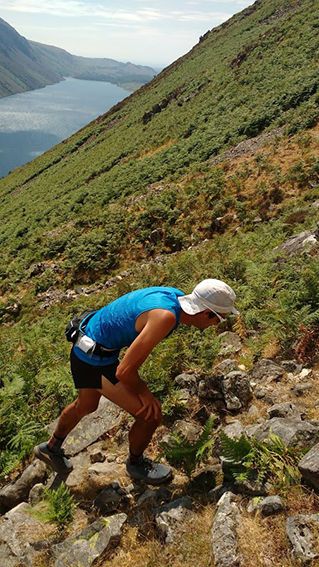
This record for the 106 kilometre/sixty-three-mile round, with 8,200 metres/28,000 feet of ascent of forty-two Lake District peaks, had been thought by many to be unbreakable. Martin was organising the logistics, and wondered if I could run with Kilian on a leg. I was delighted to be asked, but very worried about whether or not I could keep up: although I have recovered from Wainwrights round – which is now four years ago – I am still five to ten per cent slower than I was then.
I looked at the schedule and reckoned I could just about keep on legs four or five, so I offered to help on one of these. Martin put me down on leg four with Paul Tierney and Scoffer. With the ground the driest it has been for years, and warm, but not unbearably hot weather, conditions were nearly perfect for a record-breaking round.
Kilian’s plan was to keep the record attempt low key, so we were asked to keep the details private. However, by the Saturday night details were leaking out on social media. After two legs Kilian was thirty minutes up on his record-breaking schedule, and the excitement was building up on social media.
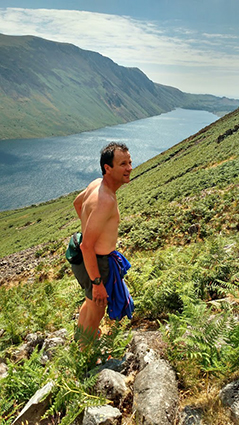
We took the long drive to Wasdale and waited for Kilian to arrive after leg three. He had picked up more time and his pacers on that leg came in looking very tired. I was even more worried about keeping up so I set off straight away while Kilian had some food and drink. We were scheduled to do thirty-three minutes to the top of Yewbarrow; working hard I managed to do it in twenty-nine minutes but was caught by Kilian, Paul and Scoffer who did it in twenty-seven minutes. I was getting dropped going up Red Pike, so I missed the summit of this and the summit of Steeple.
Kilian was loving running down the rocks, it was his recovery time, while I needed to concentrate really hard to keep with him. On the flatter sections I was finally at a relaxed enough pace to have a chat with Kilian. He was really enjoying running in the fells and the commented on the beautiful views. He was very grateful for the support team coming out and helping him. He was great to run with and checked I was OK when I fell over while running behind him.
A very small bit of rubbish blew out of his bum bag when he was getting some food out while climbing Kirk Fell. As a support runner I should be running after it and picking it up while he continues, but he immediately ran after it and picked it up before I could grab it. With my experience from doing the Wainwrights I warned him that excitement was building on social media and there would be a lot of people waiting in Keswick to see him finish.

His speed up and down Great Gable was so quick than I had to contour round to keep up but then he suddenly seemed to slow down. Instead of having to work hard to keep up, it was easy. Dropping off Grey Knotts down into Honister at the end of the leg he was struggling badly. Neil Talbott was there with his food and he stopped for a minute and ate some before continuing his descent into Honister. He had completed the leg in two hours and fifty minutes: fourteen minutes faster than his schedule. Interestingly this was the same place where Billy had a really bad patch thirty-six years earlier, and Billy had to sit down at this point to recover.
Kilian had about five minutes’ refuelling at Honister before setting off on the final leg. There were about fifty people there watching. It would have been great to see Kilian finish but I could not face the crowds. So I went home and watched a live feed as Kilian ran in to set a new record of twelve hours and fifty-two minutes; amazingly just over a whole hour faster than Billy’s previous, standing record.
It was really nice to be involved in the record and great that it has gone to someone with a genuine love and respect for the mountains.
If this sort of feat tickles your fancy, you should check out Steve’s own tale of his record-breaking Wainwright round: over 300 miles – plus many thousands of metres of ascent – in only six days and thirteen hours.
There is no Map in Hell by Steve Birkinshaw (Great book!)
For more trail running guides and narratives from Vertebrate, click here.
Words by Camilla Barnard, editor at Vertebrate Publishing, and Steve Birkinshaw.
Written by Aleks Kashefi - https://pursuingthevoid.wordpress.com
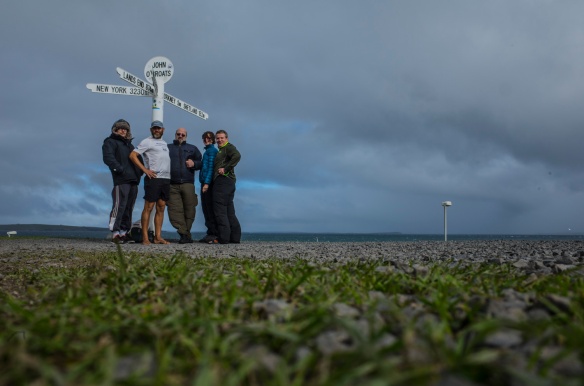
I finished at 10pm on the 2nd of September after a 53 mile day in 10 hours of running. This was the day after, having had a nice evening of celebrating with the traditional Scottish beverage. There’s nothing like making fun of yourself with a proper wolly pose ;)
Sean Conway, having completed his JogLe posted an article called the 4 elements of trail running. At the time, I was in the process of putting the final pieces of my LeJog in place, so I read with interest and even added an additional element.
Travelling for 38 days, carrying what you need to survive tends to provide you with lots of time to ponder ephemeral ideas like the nature of endurance or how we escape from that dark place we sometimes find ourselves as ultra runners. The whole elements of trail running seemed to stick in my head and it seemed to me that there are actually 3 elements to focus on. The 4 Sean Conway mentions are actually breakdowns of these 3 elements and having complete LeJog, barefooted and unsupported in 38 days, I think I can put my thoughts down (38 days is a long time to think!).
The first element, although they are all of equal importance is mechanics. I’m referring to the understanding of how you move as a person and developing the efficiency of this movement. I felt I was reasonably efficient when I ran or walked, but on the 5th day I found I was moving far better than day one. Maybe it was getting used to the 8kg pack or even the breakfast I ate, but regardless, running along the Devon section of the South West Coast path felt more fluid that running ever had. Later I was using what I knew about physiology (research in book like Anatomy for Runners and various podcasts and websites) and I would then treat the problem and alter my movement as consciously as I could to prevent the problem. My hips would hurt near the end of the trip and so I dealt with them by working on my quads that were causing the problem. The was one problem early on that could have ended the barefoot LeJog adventure after just 5 days. I was thrown off my feet by the gales of day 2 and had a lovely bruised lump on the top of my left foot. We compensate for injury, no matter how small and alter our mechanics, and mine caused severe tendentious at the join between my Achilles and my Soleous muscle.
This was hard to deal with and then leads to the second element, mentality. We train our bodies when we take on long distance running (well, any length of running or exercise) but how often do we train our brains? Day 6 was a difficult day. I had nothing to do, I could barely walk around and the time seemed to be used by my brain to think about failure. I realised a few days after that I wasn’t looking into that dark place but I had fallen in. The people who had virtually joined in, donated money and spoken to me at races before LeJog became a whole host of people I was going to let down. Then the phone buzzed and a friend sent me a message that threw my own words into my face…
“You either do something or you don’t. There’s no trying to do something”
I’d like to thank Master Yoda for that pearl of wisdom, but it had a massive impact on me. I genuinely believed those words when I spoke them and they seemed to trigger some kind of flow state. The rest of the run was rescheduled so that I had several weeks of short days and I set my mind to getting as far as I could. I think this is the part of our mentality as ultra runners that we need to celebrate and keep building. We can enter these flow states and become problem solving machines, but it seems to take utter immersion in what we’re doing and slight changes to our environment to trigger them. The other part of the mentality that is equally as important is acknowledging the suck! We know when things are bad, but we don’t always acknowledge them. I reached a point near the end of the trip where I would just admit I was tired, admit I needed to stop and once I did this, solving the problem seemed to be easier, whether it was related to physical or mental tiredness. Mental tiredness tended to end in a quick snooze and the physical tiredness was in some cases completely removed by knowing what to eat.
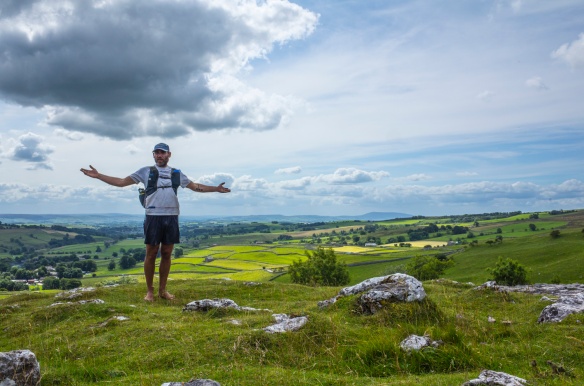
Above Malham Cove. One of the best climbs of the trip with some awesome limestone slabs to bounce around on.
Now comes the third element which is metabolism. By this I’m not just referring to what we eat, but how our bodies utilises water and the food we put in. After 2 weeks, I was barely eating anything. I would mix a bottle of tailwind up (2 scoops in 600ml) and this would last me for half a days worth of moving, followed by a refill and then an evening meal. Admittedly I was staying aerobic for most of the time, but even on the occasions where the trail was tremendous and it would be a sin not to unleash for just a few miles, I didn’t seem to need the extra fuel that we are told we need. I would go into shops after 20-30 miles and what I purchased was specific. I even left a fair few shops with no extra food and just water, even though I knew the day after would be a long one without any form of food stops. Now this is all diet based, but there is the side of metabolism that relates to what fuels we burn whilst moving and it really did seem to boil down to fat as fuel and glucose as a minor top up. I must have been doing something right though since I lost 10lbs over all, which was 4% of body fat with a 2% muscle gain. I was hoping to at least lose enough to get that coveted six pack!
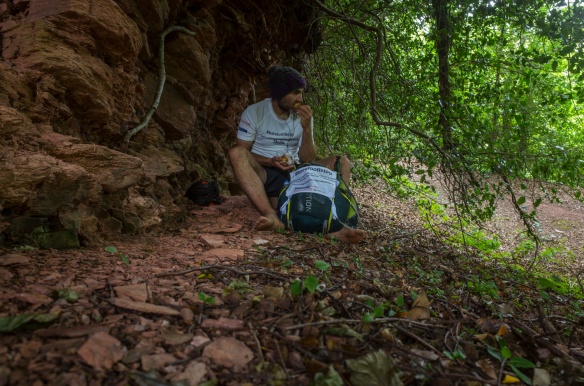
Two days after I restarted (day 9) I was lucky enough to be given a bag of left over roast potatoes and a nice lunch they made too.
Now I’ve been really brief with these elements, since I have lots of thoughts on each one, in particular the mechanics and mentality elements. They are what made the trip as successful and for the majority of time a joy to do.
What was or wasn’t on my feet aside, once I got my head around the mentality and mechanics elements the metabolism seemed to be second nature. If something hurt, I would hunt for the source of that pain, whether it was poor movement, tight muscles or the distribution of weight in my pack. Aches and pains that I was getting seemed to go, new ones developed until I found their source and they would be banished too.
It’s time to round this off as the first part. These 3 elements deserve a little more time, so I’ll be working on my thoughts some more and posting about them as distinct ideas, but as far as the LeJog write up goes, this is part 1 of a possible 3.
Hope you found something useful or interesting in this post.
Subcategories
Recipes Article Count: 10
Tips, Techniques and Training Article Count: 35
Experiences Article Count: 26
Kit Talk Article Count: 4
Psychology Article Count: 7
Random Writing Article Count: 8
Press Releases Article Count: 8
Page 3 of 4




